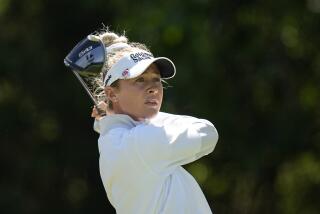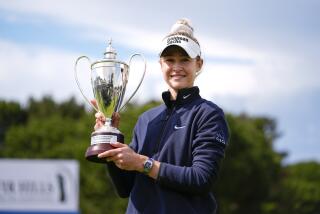Swede Roll
- Share via
The bright green “Go Annika” buttons sold out in less than a day. That’s when we should have known. The date was May 22, the place was Colonial Country Club in a leafy section of Fort Worth and the moment was one for the history books.
On both sides of the fairway, the crowd of spectators was 10 deep and they strained against the gallery ropes to try to catch a glimpse of Annika Sorenstam as she hit her tee shot, becoming the first female in 58 years to play in a tournament on the PGA Tour.
Sorenstam wedged her way into the tee area, where there was loud applause as the announcer introduced her. The fans grew quiet. She touched her cap, set up over the ball and slammed it, high and straight, down the middle of the fairway.
As the gallery cheered again when she started walking after the ball, Sorenstam pretended to swoon and patted her heart.
The record will show that Sorenstam wound up missing the cut by four shots, but that falls far short of revealing the actual impact of her accomplishment, which was both gender bending and mind-blowing.
A woman competing against the men?
Go figure.
“The most important thing of the whole Colonial [experience] is that I was being myself,” Sorenstam said. “I was playing a tournament that I wanted to play. I was challenging myself. And I think in the end people realized that. That I was challenging myself. That it was not a publicity stunt. It was for me.
“And when I can be myself and follow my dreams and set my goals, I feel very comfortable.
“In the past, I have always felt the pressure from maybe the LPGA, from people around, that I had to be somebody that I wasn’t. People compared me to Nancy Lopez and I’m the next generation and I’m going to carry the flag forward. I always felt a lot of pressure.
“So when I played at Colonial, it was a lot of pressure, but I was doing it because I wanted to do it. I think the reaction [from] the fans, the people in general, [was] that they understood what I was doing it for.
“People accepted me for the way I am and things I do. And that’s easier for me than trying to pretend to be somebody who I am not.”
What Sorenstam became during those days at Colonial was the player who produced the year’s most memorable moment in professional golf.
If Sorenstam’s goal at Colonial was to make her a better player on the LPGA Tour, she certainly accomplished that by winning two majors, the LPGA Championship and then the Women’s British Open, where she completed a career grand slam.
“Annika made it a remarkable year,” LPGA Commissioner Ty Votaw said. “For herself, for the LPGA, for all of golf.”
And as we allow ourselves time to look back, it’s not as if there wasn’t any competition.
Sorenstam dominated, but there was no lack of either golf news or the number of people making it in 2003, when the only real common thread through it all was a certain shock value bundled up and presented to the golf fan on a numbingly regular basis.
Who would have thought that any other story would edge out what shaped up as the year’s heaviest hitter, the extended flap over Augusta National’s membership and its lack of females? The Hootie Johnson-Martha Burk melodrama led to Johnson’s decision as chairman of the all-male club to foot the bill for television costs by putting its major TV sponsors on the sideline and out of the fracas.
Burk, the leader of the National Council of Women’s Organizations, vowed a protest during the Masters, but it mostly fizzled, at least partially because the protest venue was almost out of sight of the club.
Women’s issues were to be big in golf in 2003, as Sorenstam became the vanguard. Michelle Wie, only 13, played in seven LPGA Tour events and missed only one cut, and tied for ninth at the first major of the year, the Nabisco Championship. She also played a men’s Nationwide Tour event, missing the cut, and will play in the PGA Tour’s Sony Open in January.
Other female golfers who crossed the line and played in men’s professional events were Suzy Whaley, Laura Davies, Jan Stephenson and Se Ri Pak, who was 10th at an Asian Tour event in South Korea.
Against such stiff competition, the men made more than their share of headlines. Ernie Els won the first two PGA Tour events of the year, setting a tour scoring record of 31 under par in the first, won five more times worldwide, faded in his showdown with Tiger Woods at Bay Hill, but still enjoyed his best year and was rewarded by receiving absolutely zero recognition as anybody’s player of the year.
If it weren’t for Vijay Singh, Phil Mickelson would have reigned as punching bag of the year. Mickelson, who has long nurtured an inclination not to like the media much, seems to have perfected it. The spiral began in earnest when he said Woods was using “inferior equipment” and got skewered for it, even though Woods seemed to agree when he ditched his prototype Nike driver later in the year.
And when Mickelson failed to win a tournament, fell from second to 13th in the rankings, didn’t make the top 30 and play in the Tour Championship and had only two top 10s after he was third at the Masters, that was bad enough. But he earned more criticism when he tried out for the Toledo Mud Hens as a pitcher when he could have avoided it by working more on his game.
As for miserable moments, there was Thomas Bjorn’s leaving a two-shot lead in the bunker at the 16th hole at Royal St. George’s on the last day of the British Open, when he twice failed to get out of the sand.
When Singh wasn’t making news with his comments -- he was outspokenly critical of Sorenstam’s playing the Colonial -- he made it by beating Woods to win his first money title and for playing golf as a representative for the older guys.
His victory in October at Disney was the 14th PGA Tour event in 2003 won by a player over 40. The oldest was Craig Stadler at the B.C. Open, six weeks after his 50th birthday.
Woods caused a certain amount of hand wringing in the Tiger Is Infallible Camp. Even though he won five times, he didn’t win a major championship. Woods’ last win in a major was the 2002 U.S. Open.
Even though Woods didn’t bag a big one, two longshot upstarts came through famously -- Ben Curtis at the British Open and Shaun Micheel at the PGA Championship. If you add in Mike Weir’s victory at the Masters and Jim Furyk’s victory at the U.S. Open, it was the first year since 1969 that four first-time major champions claimed golf’s biggest prizes.
The sight of Tom Watson walking the last fairway to finish his opening round of 65 at the U.S. Open with the help of his caddie, Bruce Edwards, who had been diagnosed with Lou Gehrig’s Disease only five months earlier, was one of the richest moments of this or any year. Watson, who had worked with Edwards for 30 years, evolved into a spokesman for ALS research and as a fund-raiser, even handing over the $1-million annuity for winning a season-ending Champions Tour bonus pool.
As for Sorenstam’s walk on the fairways at Colonial, it was a vastly different type. She played 36 holes in two days and took 145 shots. She made two birdies, 27 pars and seven bogeys. She beat 11 players in the field. She was last in driving distance at 247.5 yards.
No, she did not make the cut, but the journey was worth it to her. Sorenstam said when she arrived at Colonial that what she was about to do felt to her like climbing Mt. Everest. After finishing her 36th hole that Friday in May, Sorenstam thought about what she had done.
“I’ve climbed as high as I can,” she said. “And it was worth every step.”
But what did it all mean? Shouldn’t the effect of such defining instances extend far beyond two days in Fort Worth?
The LPGA commissioner certainly believes so.
“I’ve always had a pretty high opinion of her as a person,” Votaw said. “What I’m happy about is that people actually know her now, more than before. She didn’t let the world in, that was just who she was. But she became more comfortable with herself in the public eye and in doing so, she became a person instead of an icon.”
There are precious few icons in golf, a stature rarely achieved while a player is still at his or her highest peak. Arnold Palmer and Jack Nicklaus are there, but they reached that pinnacle of public acceptance and reverence late in their careers. Tiger Woods, at 27 and in his prime, is probably the exception among the men.
As for female golfers, there probably are none. Lopez won 17 times in her first two years on the LPGA Tour and she comes close. Her popularity was immense, but she did not equal Sorenstam’s level of news value in the eyes of the media or the public.
There may be a comparison, at least on some level, between Woods and Sorenstam and how they have affected their professional tours. If Woods helped boost the PGA Tour’s revenue streams, through tournament prize money that doubled and record television rights fees that increased 50% to $850 million, Sorenstam has influenced the LPGA’s bottom line as well.
According to Votaw, attendance at LPGA tournaments increased 11% in 2003, television viewership was up 14% on network broadcasts and up 8% on cable when discounting war coverage, and the number of unique visitors online was up nearly 50%.
“So, attendance, television viewership, Web site traffic, our fan base is growing and with that, it makes us all the more attractive to corporate America and international companies who want to associate themselves with the LPGA,” Votaw said.
“We will see if that continues in a non-Annika individual year.”
Sorenstam’s foray into the largely unexplored territory of a woman golfer in a men’s field began innocently enough, when she answered a simple question from Miami Herald reporter Jeff Shain at a golf merchandise show in January.
Would she ever consider playing in a men’s event? Sorenstam said she would consider it. She eventually chose Colonial as the venue because it wasn’t very long, only 7,080 yards, and tournament title sponsor Bank of America warmed to the idea and the public relations benefits inherent in such an arrangement.
After that, the issue took on a life of its own and would have attracted a decent amount of media attention even without Singh, but the 40-year-old PGA Tour veteran single-handedly catapulted the notion into media hyperspace. Singh said he didn’t want Sorenstam at Colonial and that he would withdraw if paired with her.
Suddenly, it wasn’t merely Sorenstam playing golf in a men’s pro tournament, it was Annika vs. Vijay, another Battle of the Sexes, 30 years after Billie Jean King and Bobby Riggs squared off in a tennis match at the Astrodome in 1973.
“It was instantaneous combustion,” Votaw said of the Colonial episode, even though Singh pulled out of the event, he said, because he had promised his wife he’d take the week off. “You mix gender with parts of skill, it’s a potent mixture of a number of things. The whole issue of gender, openings of skill and sex, the best of one gender put to a test. It all came together to capture the imagination of the media and the public.
“And you also had the revelation of a ‘villain,’ which is how Vijay Singh was portrayed. Embroiled in controversy and turmoil, Annika at Colonial became an even more potent mix.
“But she said it herself. Annika didn’t play Colonial to make any political statements or for social commentary. It was all about her wanting to test herself as a professional golfer against that level of play. The platform she used ... if you give the world your best, the best in the world will come back to you.
“Where do we go from here? None of us have a crystal ball, but what we can say for us is that Annika was an enormous credibility factor as to what the talent level is on the LPGA Tour. It really opened some eyes. People who never saw a women’s professional golf tournament were offering opinions on what she would do.”
After opening with a one-over 71, Sorenstam still had a chance to make the cut Friday. But in an eight-hole stretch, from the fifth through the 12th, that opportunity disappeared with five bogeys.
Sorenstam said she was emotionally drained afterward.
“The attention was more than I expected,” she said. “I think the length wasn’t a problem, it was just everything around it. Being under the microscope and then when I really didn’t perform as well as I think I can.”
That Friday afternoon at Colonial, Sorenstam said she was going back to the LPGA Tour where she belonged and that she was leaving the men’s tour to the PGA Tour pros. After all, she had accomplished her mission. Now, she would turn her attention to getting better on the LPGA Tour.
Is it a coincidence that Sorenstam won two majors and six tournaments in all? Or that she was inducted into the World Golf Hall of Fame in October? Or that she wrapped up another Rolex player-of-the-year award, her sixth?
If Colonial was a turning point for Sorenstam, it represented just such an advancement for golf, and in 2003, there was no bigger story.
More to Read
Go beyond the scoreboard
Get the latest on L.A.'s teams in the daily Sports Report newsletter.
You may occasionally receive promotional content from the Los Angeles Times.










